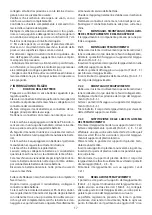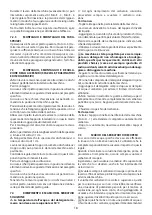
30
ers.
- Disconnect and remove the batteries.
Place the machine on the original pallet (or an equivalent
one that can bear the weight and is big enough for the
machine’s overall dimensions) using an inclined surface.
Solidly anchor the machine and the squeegee to the pal-
let using metallic brackets or other elements that can
bear the weight of the parts.
Lift the pallet with the machine and load it on the trans-
port vehicle.
Secure the machine and the pallet using ropes connected
to the transport vehicle.
As an alternative, when using private transport vehicles,
use inclined ramps to push the machine without the
pallet, making sure to protect all parts and the machine
itself against violent impacts, humidity, vibrations and ac-
cidental movements during transport.
The battery boxes have holes where tools can be hooked
for handling.
•
To lift or insert the battery (into the machine com-
partment), use only suitable personnel and equipment
(cables, eyehooks, etc.) for the operation and to bear the
weight of the loads involved. When transporting, take the
same precautions and follow the same instructions pro-
vided for the machine together with those in the special
manufacturer’s manual.
The battery charger can be transported on its supports,
both vertically and horizontally. Take the same precau-
tions and follow the same instructions provided for the
machine together with those in the special manufac-
turer’s manual.
5. TECHNICAL INFORMATIONS
5.1
GENERAL DESCRIPTION
5.1.1 BATTERIES
Regardless of the type of construction, battery perfor-
mances are indicated with the term capacity, which
always refers to a discharge period. Another important
value is the number of possible discharges. The capacity
is expressed in amps per hour (Ah), while the discharge
period is generally indicated as 20 hours (C20 or 20h, or
not expressly indicated) or 5 hours (C5 or 5h). The dis-
charge/charge cycles indicate the number of times that
the battery can hold a charge under the best conditions,
i.e. they indicate the useful battery service life complying
with all the necessary measures.
Therefore, the capacity of a battery varies depending on
how fast it uses energy (current). That’s why there’s such
a variation in the capacity values expressed as C5 or C20.
These factors must be taken into account when compar-
ing products available on the market with our own.
This machine can be equipped with two types of batter-
ies that differ in terms of their construction and features.
- Pb-Acid battery with tubular armoured modules: the
electrolyte level in each element must be periodically
checked!
•
If one element is no longer covered by the acid solu-
tion it will oxidise in 24 hours, thus permanently affecting
that element’s performance.
☞
Refer to the battery manual to avoid physical damage
and economic loss.
- Gel module battery: this type of battery is mainte-
nance free and does not require special environments
for recharging (since it does not emit any harmful gases);
therefore, it is highly recommended.
•
It should not be taken for granted that batteries and
battery chargers with the same technical features as
those we offer will produce the same results. Only perfect
compatibility between these elements (Pb-Acid batteries,
gel batteries and battery chargers) will safeguard the per-
formances, the service life, the safety and the economic
value invested.
5.1.2
BATTERY CHARGER
This type of high-frequency battery charger efficiently
charges batteries, extending their operating and service
life. In addition, because they can be configured, it is a
very versatile solution; the same battery charger can be
used for both Pb-Acid batteries and for gel batteries.
•
It should not be taken for granted that batteries and
battery chargers with the same technical features as
those we offer will produce the same results. Only perfect
compatibility between these elements (Pb-Acid batteries,
gel batteries and battery chargers) will safeguard the per-
formances, the service life, the safety and the economic
value invested.
5.2
STRUCTURE AND FUNCTIONS
5.2.1 MACHINE
Photo A
1 Recovery tank
2 Operator’s seat
3 Solution tank
4 Rear wheel
5 Bumper wheel
6 Splash guard
7 Traction control pedal
8 Squeegee lifting/lowering lever
9 Steering wheel
Photo B
1 Recovery water tank drain hose
2 Recovery water tank drain hose plug
3 Solution water tank filling plug
4 Suction hose
5 Suction hood and access to the
recovery tank
Photo C
1 Blinker
2 Suction hood
3 Suction filter
4 Recovery tank
Photo D
1 Solution water tank drain plug
Photo E
Summary of Contents for CRS 66 BT
Page 3: ...3 1 2 A B 1 5 4 2 7 4 5 6 9 8 3 3...
Page 4: ...4 C 1 1 D 3 4 2...
Page 5: ...5 3 3 2 1 4 6 7 6 7 1 2 5 E F 1...
Page 6: ...6 H 2 G 1 3 3 1 4 2...
Page 8: ...8 1 L 2 2 4 1 M 3...
Page 9: ...9 N O 1 2 2 3 6 7 5 4 0 8 1 7 2 2 2 9 4 3 0 4 H2O CHEM 1 2 1 1 1 0 1 3 1 7 2 5 1...
Page 104: ...104 8 6 2 1 OFF O SPEED N 1 N 6 ON I N 7 N 1 N 6 SPEED N 2 SET CTM FASA LAVORPRO...
Page 105: ...105 7 3 12...
Page 106: ...106 6...
Page 107: ...107 5 2 10...
Page 108: ...108 4 4 35 10 50 30 95...
Page 109: ...109 3 5 1 CE CE 2 1 2...
Page 110: ...110 2 3 1 CE 4 1...
Page 111: ...111 1 1 1 1 1 2...
Page 113: ...113 2 2 1 2 2 2 10 2 3 2 4 2 5...
Page 114: ...114 3 3 1 4 35 C 10 50 C 30 95 2 10...
Page 115: ...115 3 2 96 4 4 1 4 2 4 3 4 4...
Page 116: ...116 L L 1 L 2 L 1 L 1 4 5 5 5 1 5 1 1 20 20 20 5 C5 5 C5 20 24 5 1 2...
Page 121: ...121 D 1 7 5 7 6 7 7 7 7 1 7 7 2...
Page 122: ...122 7 7 3 2 7 7 4 7 8 3 2 7 7 5...
Page 123: ...123 7 4 7 5 7 4 7 5 8 8 1 50 8 2 8 3 8 4 8 5 8 6 8 7 8 7 1...
Page 124: ...124 8 7 2 8 8 8 9...
Page 125: ...125 X X X X X X X X X X X X X X X X X X...
Page 127: ...127 9 2 9 2 1 1 30 9 2 2 5 9 2 3 9 2 4 9 2 5...
Page 128: ...128 9 2 6 9 2 7 9 2 8 9 2 9 9 2 10 100 20 30 10 12...
Page 129: ...129 10 1 2013 56 EU 10 2 WEE 2002 96 EC 27 2003 2002 96 EC...










































